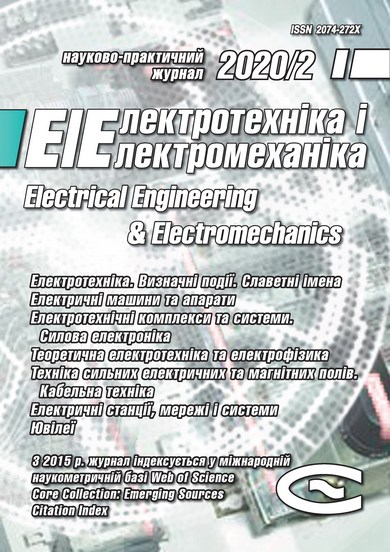A METHOD OF WAVELET ANALYSIS OF TIME SERIES OF PARAMETERS OF DIELECTRIC ABSORPTION OF ELECTRICAL INSULATING STRUCTURES
DOI:
https://doi.org/10.20998/2074-272X.2020.2.08Keywords:
dielectric absorption parameters, capacitance, dielectric loss tangent, spectrum of time series, low-pass filter, decomposition levels, approximation and detail, wavelet transformAbstract
Introduction. In the objects of control there are always a number of interfaces, for example, solid insulation – electrode. On contacting surfaces, free surface charges are transferred. Surface conductivity leads to fluctuations in the measured values of the capacitance and the tangent of the dielectric loss angle of solid insulation, the state of which is determined. The drain off of the surface charge does not lead to a decrease in the scatter of the measured dielectric absorption parameters. One of the main reasons for the significant time spread of the dielectric absorption parameters, and to a large extent (three orders of magnitude) of the dielectric loss tangent are tribo charges caused by triboelectrification of cable structural elements. Tribo charges cause internal noise in electrical insulating structures, masking processes in the polymer insulation itself. Purpose. Substantiation of a method for analyzing the time series of dielectric absorption parameters, which provides increased accuracy of control and diagnostics of solid polymer insulation of electrical insulation structures based on filtering experimental data using wavelet transform. Methodology. The inefficiency of filtering the spectra of time series using a low filter based on the direct Fourier transform is shown. Multilevel wavelet decomposition of the time series of parameters is presented, and the efficiency of applying wavelet transforms to identify high-frequency and low-frequency components in the measured values. Practical value. The method of analyzing the time series of dielectric absorption parameters using the wavelet transform, proposed for the first time, makes it possible to increase the accuracy of monitoring and diagnostics of solid polymer insulation both at the manufacturing stage and in the operation of electrical insulating structures. This method is the basis for creating a database of control results for assessing the state of solid polymer insulation of electrical insulation structures, in particular, power and information cables.References
KholodnyS.D., Serebryannikov S.V., Boev M.A. Metody ispytanii i diagnostiki v elektroizoliatsionnoi i kabel'noi tekhnike [Testing and diagnostic methods in electrical insulation and cable technology]. Publishing House MEI, 2009. 232 p. (Rus).
Bezprozvannych G.V., Roginskiy A.V. Dielectric spectroscopy of casing thermosetting composite electrical insulation system of induction traction electric machines. Electrical engineering & electromechanics, 2018, no.1, pp. 17-20. doi: 10.20998/2074-272X.2018.1.02.
Bezprozvannych G.V., Kostyukov I.A., Roginsky A.V. Characteristics of cased electrical insulation system of asynchronous electrical machines at resonance frequency. Technical electrodynamics, 2019, no. 4. pp. 48-55. (Rus). doi: 10.15407/techned2019.04.048.
Bezprozvannych G.V., Boyko A.N. Substantiation and guaranteeing of technological parameters of triboelectrical method of monitoring of cables with polymer insulation. Electrical Engineering & electromechanics, 2014, no. 6, pp. 56-60. (Rus). doi: 10.20998/2074-272x.2014.6.10.
Bezprozvannych G.V., Boyko A.M. Electrostatic processes in power cables. Electrical engineering & electromechanics, 2013, no.4, pp. 27-31. (Ukr).
Bezprozvannych G. V., Boyko A.M. Experimental determination of triboelectric potential in unshielded and shielded network cables. Electrical engineering & electromechanics, 2012, no. 3, pp. 56-60. (Ukr).
Bezprozvannych G.V., Boyko A.N. Contact potential difference as a measure of power cable polymer insulation aging. Electrical engineering & electromechanics, 2014, no. 5, pp. 62-66. (Rus). doi: 10.20998/2074-272x.2014.5.12.
Bezprozvannych G.V., Boyko A.N. Distribution of surface density of charges on the interface between contacting isolated conductors of the cables. Technical Electrodynamics, 2014, no.6. pp. 18-23. (Rus).
Ango A. Matematika dlja elektro- i radioinzhenerov [Mathematics for electro- and radioengineers].Moscow, Nauka Publ., 1965. 780 p. (Rus).
Korn G., Korn T. Spravochnik po matematike dlia nauchnykh rabotnikov i inzhenerov [Mathematical handbook for scientists and engineers]. Moscow, Nauka Publ., 1977. 830 p. (Rus).
Sergienko A.B. Tsifrovaia obrabotka signalov [Digital signal processing]. St. Petersburg, BHV Publ., 2011. 768 p. (Rus).
Potemkin V.G. Sistema MATLAB [MATLAB System]. Moscow, DIALOG-MIFI Publ., 1998. 350 p. (Rus).
Dyakonov V.P. MATLAB i SIMULINK dlia radioinzhenerov [MATLAB and SIMULINK for radio engineers]. Moscow, DMK Press Publ., 2011. 976 p. (Rus).
Malla S. Veivlety v obrabotke signalov [Wavelets in signal processing]. Moscow, Mir Publ., 2005. 671 p. (Rus).
Fraser M. Vvedenie v veivlety v svete lineinoi algebry [Introduction to wavelets in the light of linear algebra]. Moscow, BINOM. Laboratory of Knowledge Publ., 2010. 487 p. (Rus).
Daubechies I. Desiat' lektsii po veivletam [Ten lectures on wavelets]. Izhevsk, SIC «Regular and chaotic dynamics» Publ., 2001. 464 p. (Rus).
Bezprozvannych G.V., Kostiukov I.A. Error of control of electrical insulation structures by dielectric absorption parameters according to the concept of uncertainty of measurements. Electrical engineering & electromechanics, 2020, no.1, pp. 47-51. doi: 10.20998/2074-272X.2020.1.07.
Downloads
Published
How to Cite
Issue
Section
License
Copyright (c) 2020 G. V. Bezprozvannych, I. A. Kostiukov

This work is licensed under a Creative Commons Attribution-NonCommercial 4.0 International License.
Authors who publish with this journal agree to the following terms:
1. Authors retain copyright and grant the journal right of first publication with the work simultaneously licensed under a Creative Commons Attribution License that allows others to share the work with an acknowledgement of the work's authorship and initial publication in this journal.
2. Authors are able to enter into separate, additional contractual arrangements for the non-exclusive distribution of the journal's published version of the work (e.g., post it to an institutional repository or publish it in a book), with an acknowledgement of its initial publication in this journal.
3. Authors are permitted and encouraged to post their work online (e.g., in institutional repositories or on their website) prior to and during the submission process, as it can lead to productive exchanges, as well as earlier and greater citation of published work.





